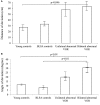Vestibular Loss in Older Adults Is Associated with Impaired Spatial Navigation: Data from the Triangle Completion Task
- PMID: 28496432
- PMCID: PMC5406402
- DOI: 10.3389/fneur.2017.00173
Vestibular Loss in Older Adults Is Associated with Impaired Spatial Navigation: Data from the Triangle Completion Task
Abstract
Background: Vestibular inputs have been shown to play a critical role in spatial navigation. In this study, we sought to evaluate whether vestibular loss due to aging contributes to impaired spatial navigation as measured by the triangle completion task (TCT).
Materials and methods: We recruited three types of participants: young controls <55 years of age, older controls ≥55 years of age, and older patients from a Neurotology Clinic with evidence of vestibular physiologic impairment but who did not have any known vestibular disorder. We performed the cervical vestibular-evoked myogenic potential to evaluate saccular function and video head impulse testing to quantify horizontal semicircular canal vestibulo-ocular reflex gain. To assess spatial navigation ability, we administered the TCT, in which participants were conveyed along two segments of a pre-drawn triangular path and instructed to complete the final segment independently. We measured the angle (degrees) and distance (centimeters) of deviation from the correct trajectory. We evaluated the influence of vestibular inputs on TCT performance.
Results: Forty-eight adults participated in the study (mean age: 62.0 years; 52.1% females), including 9 young controls, 15 older controls, and 24 clinic patients. Clinic patients had the greatest distance of deviation (67.7 cm), followed by older controls (45.4 cm), then young controls (27.8 cm; p < 0.01). Similarly, clinic patients had greater rotational angles (22.1°) compared to older (13.3°) and younger controls (12.4°; p < 0.01). Following multivariate linear regression adjusting for demographic variables, loss of otolith function was associated with an 18.2 cm increase in distance of deviation (95% CI: 15.2-47.4) and a 9.2° increase in rotational angle (95% CI: 3.0-15.5). Abnormal semicircular canal function was associated with a 26.0 cm increase in distance of deviation (95% CI: 0.2-51.8) and a 10.8° increase in rotational angle (95% CI: 3.0-15.5). Participants with both otolith and canal abnormalities had a larger distance error (β = 25.3, 95% CI: 6.2-44.4) and angle of deviation (β = 18.1, 95% CI: 10.1-26.2) than with either condition alone.
Conclusion: Vestibular loss in older adults was associated with poorer performance on a dynamic spatial navigation task relative to old and young controls.
Keywords: aging; path integration; spatial navigation; triangle completion task; vestibular system; visuospatial cognition.
Figures


Similar articles
-
Utricular Dysfunction and Hearing Impairment Affect Spatial Navigation in Community-Dwelling Healthy Adults: Analysis from the Baltimore Longitudinal Study of Aging.Audiol Neurootol. 2024;29(5):357-366. doi: 10.1159/000537769. Epub 2024 Mar 15. Audiol Neurootol. 2024. PMID: 38493767
-
Saccular function is associated with both angular and distance errors on the triangle completion test.Clin Neurophysiol. 2019 Nov;130(11):2137-2143. doi: 10.1016/j.clinph.2019.08.027. Epub 2019 Sep 17. Clin Neurophysiol. 2019. PMID: 31569041 Free PMC article.
-
Self-Reported Sense of Direction and Vestibular Function in the Baltimore Longitudinal Study of Aging (BLSA).J Assoc Res Otolaryngol. 2021 Apr;22(2):207-214. doi: 10.1007/s10162-020-00780-1. Epub 2021 Jan 15. J Assoc Res Otolaryngol. 2021. PMID: 33449237 Free PMC article.
-
Otolith and canal integration on single vestibular neurons in cats.Exp Brain Res. 2005 Jul;164(3):271-85. doi: 10.1007/s00221-005-2341-7. Epub 2005 Jul 1. Exp Brain Res. 2005. PMID: 15991028 Review.
-
Perspectives for the comprehensive examination of semicircular canal and otolith function.Biol Sci Space. 2001 Dec;15(4):393-400. doi: 10.2187/bss.15.393. Biol Sci Space. 2001. PMID: 12101365 Review.
Cited by
-
Navigation strategies in patients with vestibular loss tested in a virtual reality T-maze.J Neurol. 2022 Aug;269(8):4333-4348. doi: 10.1007/s00415-022-11069-z. Epub 2022 Mar 20. J Neurol. 2022. PMID: 35306619
-
How path integration abilities of blind people change in different exploration conditions.Front Neurosci. 2024 May 17;18:1375225. doi: 10.3389/fnins.2024.1375225. eCollection 2024. Front Neurosci. 2024. PMID: 38826777 Free PMC article.
-
Functional impact of bilateral vestibular loss and the unexplained complaint of oscillopsia.Front Neurol. 2024 Apr 22;15:1365369. doi: 10.3389/fneur.2024.1365369. eCollection 2024. Front Neurol. 2024. PMID: 38711564 Free PMC article.
-
Mechanisms and Impact of Aminoglycoside-Induced Vestibular Deficits.Am J Audiol. 2023 Nov;32(3S):746-760. doi: 10.1044/2023_AJA-22-00199. Epub 2023 Jun 15. Am J Audiol. 2023. PMID: 37319406 Free PMC article. Review.
-
The Gait Disorientation Test: A New Method for Screening Adults With Dizziness and Imbalance.Arch Phys Med Rehabil. 2021 Apr;102(4):582-590. doi: 10.1016/j.apmr.2020.11.010. Epub 2020 Dec 15. Arch Phys Med Rehabil. 2021. PMID: 33338462 Free PMC article.
References
-
- Marquardt G. Wayfinding for people with dementia: a review of the role of architectural design. HERD (2011) 4(2):75–90. - PubMed
LinkOut - more resources
Full Text Sources
Other Literature Sources

